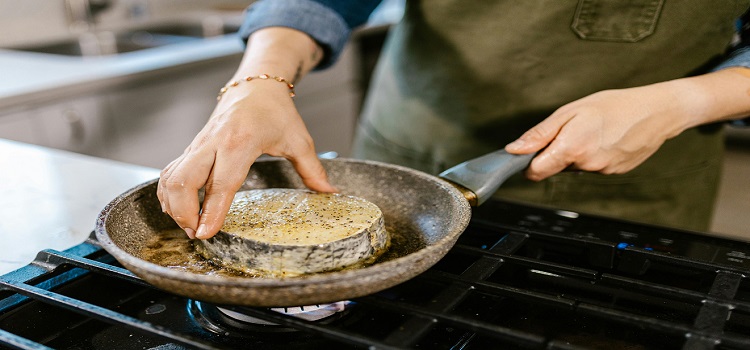As an Amazon Associate I earn from qualifying purchases.
How to Cook Frozen Fish in a Pan: A Comprehensive Guide
Cooking frozen fish in a pan is a convenient and straightforward method that can yield delicious results without requiring extensive preparation. Whether you’re in a hurry or simply didn’t plan ahead for dinner, this guide will provide you with everything you need to know about cooking frozen fish in a pan, including techniques, tips, and variations to create a tasty meal.

Understanding Frozen Fish
Frozen fish is a popular choice for many home cooks due to its long shelf life and availability. Freezing fish helps retain its nutrients and flavor, making it a healthy option when fresh fish isn’t available. Common types of frozen fish include:
- Salmon
- Tilapia
- Cod
- Haddock
- Trout
Preparing to Cook Frozen Fish
Before you begin cooking, it’s essential to gather your ingredients and tools:
Ingredients
- Frozen Fish Fillets: Choose your preferred type (about 6-8 ounces per serving).
- Cooking Oil: Olive oil, vegetable oil, or butter work well.
- Seasonings: Salt, pepper, garlic powder, paprika, or any herbs/spices you prefer.
- Lemon or Lime (Optional): For serving and added flavor.
- Fresh Herbs (Optional): Parsley, dill, or cilantro for garnish.
Tools
- Non-Stick Skillet or Frying Pan: A heavy-bottomed pan works best for even cooking.
- Spatula: For flipping the fish.
- Lid: To cover the pan (optional).
Step-by-Step Instructions
1. Thawing (Optional)
While you can cook frozen fish directly from the freezer, thawing it can enhance the texture and flavor. If you choose to thaw, do so safely:
- Refrigerator Method: Place the fish in the refrigerator for 6-8 hours or overnight.
- Cold Water Method: Seal the fish in a plastic bag and submerge it in cold water for about 30 minutes.
2. Pat Dry
Once thawed, or if cooking from frozen, pat the fish fillets dry with paper towels. Removing excess moisture helps achieve a crispy exterior and prevents steaming during cooking.
3. Season the Fish
- Sprinkle both sides of the fish fillets with salt, pepper, and any other seasonings you prefer. This step enhances the flavor and creates a delicious crust when cooking.
4. Heat the Pan
- Place a non-stick skillet or frying pan over medium-high heat.
- Add 1-2 tablespoons of cooking oil or butter. Allow it to heat until it shimmers (for oil) or melts completely (for butter).
5. Cooking the Fish
- Add the Fish: Carefully place the fish fillets in the hot pan, skin side down (if applicable). Ensure there’s enough space between the fillets to avoid overcrowding.
- Cook the First Side: Let the fish cook undisturbed for about 4-5 minutes. For frozen fish, it may take slightly longer, so adjust the time accordingly. The fish will begin to turn opaque and flake easily when cooked.
- Flip the Fish: Using a spatula, gently flip the fillets to the other side. If you have a lid, cover the pan for a couple of minutes to help cook the fish through evenly and retain moisture.
- Cook Until Done: Continue cooking for another 4-5 minutes. The fish is done when it reaches an internal temperature of 145°F (63°C) and flakes easily with a fork.
6. Add Finishing Touches
- Optional Squeeze of Citrus: Just before serving, squeeze fresh lemon or lime juice over the fish for added brightness.
- Garnish: Sprinkle with fresh herbs for color and flavor.
Serving Suggestions
Now that your fish is cooked to perfection, it’s time to serve it! Here are a few ideas for side dishes to complement your fish:
- Steamed Vegetables: Broccoli, asparagus, or green beans add a healthy touch.
- Rice or Quinoa: A side of fluffy rice or quinoa makes for a filling meal.
- Salad: A fresh green salad with a light vinaigrette balances the richness of the fish.
Tips for Success
- Avoid Overcooking: Fish can dry out quickly, so keep a close eye on cooking time. Check for doneness rather than relying solely on time.
- Adjust Seasonings: Experiment with different spices or marinades to find your favorite flavor profile.
- Choose Quality Fish: Whenever possible, opt for sustainably sourced fish. Look for fish labeled as “wild-caught” or “sustainably farmed.”
- Experiment with Cooking Methods: In addition to pan-searing, you can try baking or grilling your frozen fish for different textures and flavors.
Storage Tips
If you have leftover cooked fish, store it properly to ensure freshness:
- Refrigerate: Place any leftovers in an airtight container and refrigerate for up to 2 days.
- Freeze: For longer storage, you can freeze cooked fish. Wrap it tightly in plastic wrap and then in aluminum foil or place it in a freezer-safe container. Consume within 3 months for the best quality.
Conclusion
Cooking frozen fish in a pan is not only quick and easy but also results in a delicious, healthy meal. With the right techniques, you can enjoy flaky, flavorful fish any night of the week, even if you didn’t have time to thaw ahead of time. By following this comprehensive guide, you’ll be well-equipped to create a mouthwatering dish that’s sure to impress. Enjoy your culinary adventure with frozen fish, and don’t hesitate to explore different flavors and cooking styles!
As an Amazon Associate I earn from qualifying purchases.
Leave a Reply